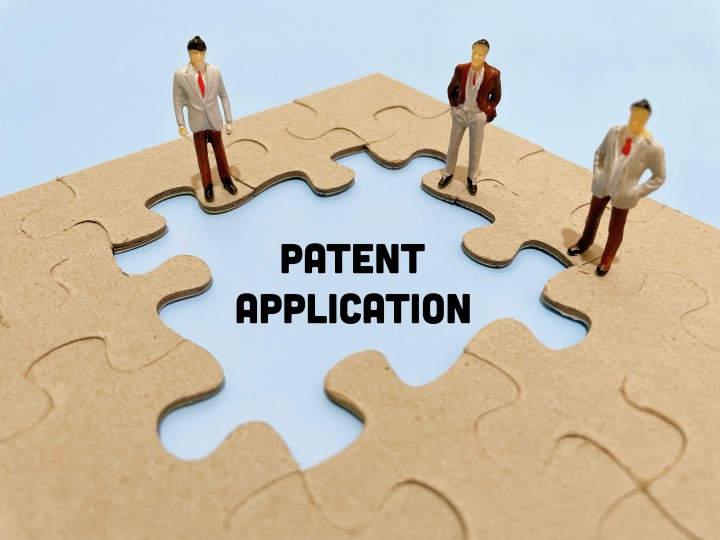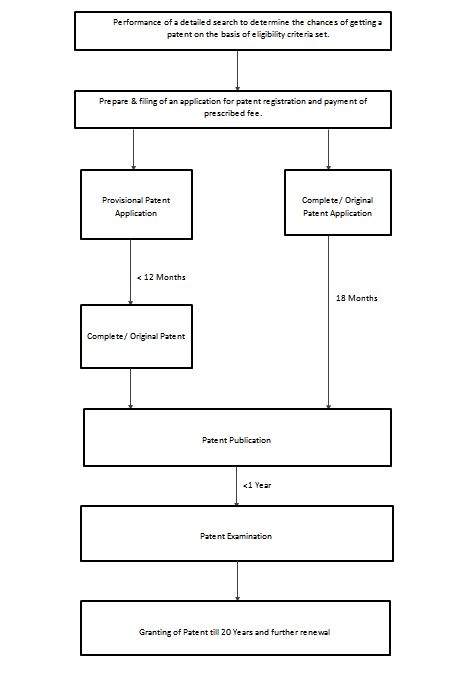Now Reading: Procedure to File Patent in India
-
01
Procedure to File Patent in India

Procedure to File Patent in India
An Intellectual Property Right (IPR) is a volatile right “protecting commercially valuable products of the human intellect”. It comprises patents, copyrights, trademarks and other similar rights.
Patent is one of the pillars of IPR and it gives its owners exclusionary rights over the invention.
The word patent is derived from the Latin word ‘Patere’ which means ‘to open’ or ‘lying open’.
Patent is defined as a constitutional privilege granted by the government to inventors, and to other persons deriving their rights from the inventor.
It is a domination right approved by the Government to exclude others from exploiting or using a particular invention. This exclusive monopoly granted by way of patent is a cartel right, which offers exclusivity to the patentee to exploit the invention for 20 years after which it falls to the public domain.
A Patent granted under the provisions of the Patents Act, 1970[1] enables the patentee exclusive right to make, use, exercise, sell or distribute the patented article or substance, and to use or exercise the patented process. The act seeks to provide for legal protection of inventions. It even helps in identifying emerging technologies and further emerging areas.
The objective of the patent law is to provide a right to owner of the patent for a certain period of time for disclosing its invention, to use it and to practice that invention and make it work; therefore encouraging scientific research, new technology, stimulate new inventions of commercial utility and pass invention into public domain after the expiry of the fixed period of the monopoly.
If the grant of the patent is for a product, then the inventor has a right to prevent others from making, using, offering for sale, selling or importing the patented product in India.
If the patent is for a process, then the inventor has the right to prevent others from using the process, using the product directly obtained by the process, offering for sale, selling or importing the product in India directly obtained by the process.
WHO CAN APPLY FOR PATENTS?
- True and first inventor of the invention;
- Assignee of the true and first inventor of the invention;
- Legal representative of the deceased person who was entitled to immediately make such application before his death.
An application can be made by any of the above persons either alone or jointly with any other person(s).
CONDITIONS OF PATENTABILITY
An invention must meet several standards if it needs to be eligible for patent protection. These includes:-
- Most expressively, that the invention must consist of a patentable subject matter,
- The invention must be industrially useful,
- It must be novel (new),
- It must unveil a sufficient “inventive step”, and
- The complete revelation of the invention in the patent application must meet assured standards.
The three main patent eligibility criteria are described as below:
- Novelty
Novelty is a basic requirement in any examination and is an undisputed condition of patentability. An invention is new if it is not anticipated by the prior art.
- Inventive Step (Non-Obviousness)
In relation to the requirement of inventive step, one needs to seek answer to the question as to “whether the invention would have been obvious to a person having ordinary skill in the art or not” in order to determine in the examination as to substance.
- Industrial application
In order to be patented, an invention must have an industrial application.
Section 2(1)(ac) of The Patents Act, 1970, states about “capable of industrial application” if any invention can be made or used in any kind of industry, then it is known to be a subject matter with industrial capability.
In today’s scenario, the aggressive and targeted patenting is the need of the hour; in order to encourage more innovations and research and development and to attain monopoly right over their intellectual work. The traditional patent search technologies were so complex, and patent databases have had become so large, that comprehensive patent searches could take days to execute and the need was felt to optimize both the search process and the ability to deliver actionable observation by getting advanced analysis tools; and hence in India, there was adoption of a specified procedure set to file Patent.
The very first recommendable step in patent registration procedure is to perform a detailed search to determine the chances of getting a patent on the basis of eligibility criteria set.
The next step is to prepare an application for registration.
There are two different types of patent registration application: Provisional and Complete.
Provisional Application– It is often the first or transitory application filed in respect of an invention which is still in the experiment stage but have a clear thought behind the innovation, and usually contains only a brief description of the invention.
As the word ‘provisional’ suggests, it is not a final legal documentation with respect to patency and is suggested to file only if the inventor has incomplete information or just an idea and have an intention to get some time period to develop the product or gain complete information of the invention.
And once this application is filled and accepted, then the applicant can put the tag of “patent pending” on the product desired to be patented and due to this, he enjoys all the patent rights on that invention.
It must be noted that within twelve months from the date filing of the provisional specification, original or complete specification must be filed and it implies that the inventor needs to conclude the innovation and to assess its marketability potential within such period.
Original or Complete Application– It consists of full description and disclosure of the invention; stating its title, field of invention, the background of the invention, the description of the related art, drawbacks of the prior art, the summary of the invention, the brief description of the figures, the detailed description of the preferred embodiments, claims and abstract.
In case where the product or process invented is already completed, there is no necessity of temporary application. The inventor can directly file by way of original or complete application with all the requirements at once.
Next, Filing and Prosecuting Patent Applications-
The procedure for the grant of a patent starts with filing of the patent application and paying off the prescribed fee at the patent office or online, and then after the publication of the application, filing of request for examination, in the prescribed form.
The applications are examined significantly and a first examination report stating the objections, if any, is communicated to the applicant. Application may be amended in order to meet these objections.
If there is failure of complying with the objections, the application will be left there and then.
After complying off the requirements, the application is published in the Official Journal. Patent will be granted if the application is found to be in order. Then, the application and other related documents will be open for public inspection. Thereafter, at any time between granting and before expiration of period of one year from the date of publication, there is availability of provision regarding opposition on substantive grounds. And after the expiration of the said period and in case of non- objection, final patent is issued.
COMPLETE LICENSING
Compulsory License is an important part of the Patent system. The 1970 Act by way of several amendments explored the phenomenon of compulsory licensing and the grant of compulsory license that are contained in the section 84 to 92 of the Act.
The compulsory license can be granted in India at any time after the expiration of three years from the date of the sealing of a patent, any person interested can make an application to the Controller for grant of compulsory license on patent on any of the below mentioned grounds as per section 84(1)of the Act[2]:
- If reasonable requirements of the public have not been satisfied;
- If the patent invention is not available to the public at an affordable price; and
iii. If the patent invention is not worked in the territory of India.
Types of patent licenses
There are two types of patent licenses as mentioned below:
Exclusive license: A patent owner transfers all aspects of ownership to the licensee only retaining the title to the patent. The patent owner surrenders all rights under the patent (including the right to sue for infringement and the right to license) to the licensee.
The licensee obtains the right to sub-license the patent and sue for patent infringement. However, the exclusivity can be limited by a field of use as per the contractual obligations (written or oral), like, the patent owner promised the licensee that for the specified filed of use, nobody else will be licensed.
Non-exclusive license: By granting a non-exclusive license, the patent owner principally promises not to sue the licensee for patent infringement. It is assumed that acquiring this type of license, the licensee acquires the freedom to operate in the space protected by the licensed patent, but this may depend on whether the licensee’s products infringe other patents or not.
[1] http://www.ipindia.nic.in/writereaddata/Portal/IPOAct/1_31_1_patent-act-1970-11march2015.pdf








